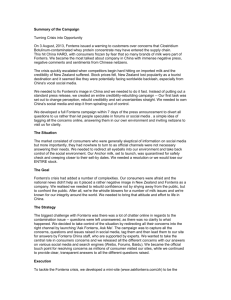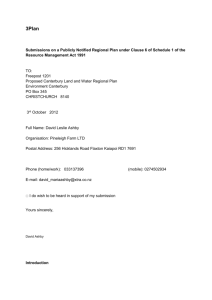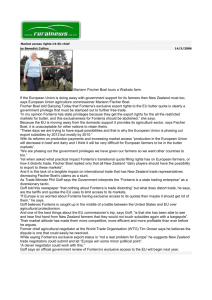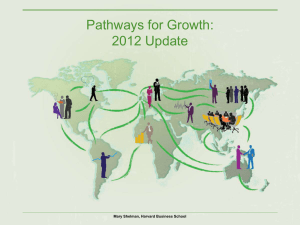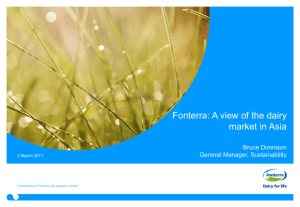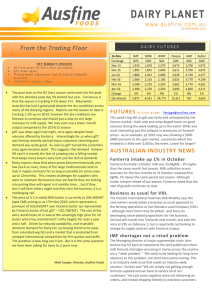Dairy Industry Strategy and Structure as
advertisement
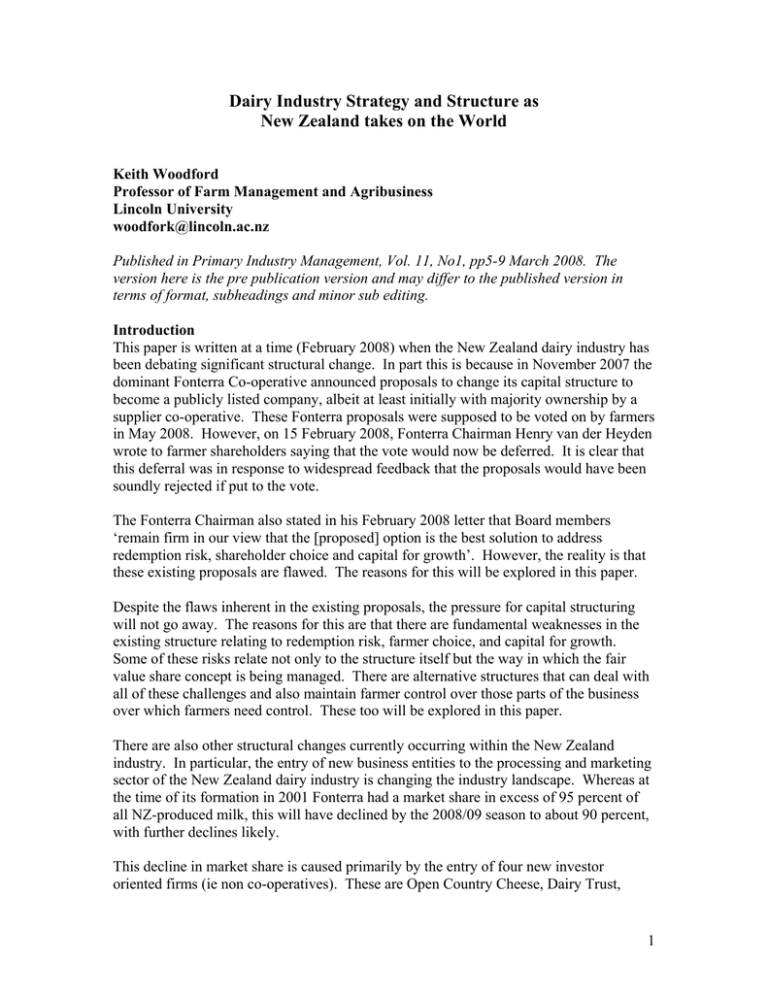
Dairy Industry Strategy and Structure as New Zealand takes on the World Keith Woodford Professor of Farm Management and Agribusiness Lincoln University woodfork@lincoln.ac.nz Published in Primary Industry Management, Vol. 11, No1, pp5-9 March 2008. The version here is the pre publication version and may differ to the published version in terms of format, subheadings and minor sub editing. Introduction This paper is written at a time (February 2008) when the New Zealand dairy industry has been debating significant structural change. In part this is because in November 2007 the dominant Fonterra Co-operative announced proposals to change its capital structure to become a publicly listed company, albeit at least initially with majority ownership by a supplier co-operative. These Fonterra proposals were supposed to be voted on by farmers in May 2008. However, on 15 February 2008, Fonterra Chairman Henry van der Heyden wrote to farmer shareholders saying that the vote would now be deferred. It is clear that this deferral was in response to widespread feedback that the proposals would have been soundly rejected if put to the vote. The Fonterra Chairman also stated in his February 2008 letter that Board members ‘remain firm in our view that the [proposed] option is the best solution to address redemption risk, shareholder choice and capital for growth’. However, the reality is that these existing proposals are flawed. The reasons for this will be explored in this paper. Despite the flaws inherent in the existing proposals, the pressure for capital structuring will not go away. The reasons for this are that there are fundamental weaknesses in the existing structure relating to redemption risk, farmer choice, and capital for growth. Some of these risks relate not only to the structure itself but the way in which the fair value share concept is being managed. There are alternative structures that can deal with all of these challenges and also maintain farmer control over those parts of the business over which farmers need control. These too will be explored in this paper. There are also other structural changes currently occurring within the New Zealand industry. In particular, the entry of new business entities to the processing and marketing sector of the New Zealand dairy industry is changing the industry landscape. Whereas at the time of its formation in 2001 Fonterra had a market share in excess of 95 percent of all NZ-produced milk, this will have declined by the 2008/09 season to about 90 percent, with further declines likely. This decline in market share is caused primarily by the entry of four new investor oriented firms (ie non co-operatives). These are Open Country Cheese, Dairy Trust, 1 Synlait and New Zealand Dairies. In addition, the regional Westland Dairy Co-operative has been growing faster than Fonterra, and now comprises about 4 percent of the national industry. The Tatua Co-operative in the Waikato has a market share of approximately 1 percent. There are also other emerging small players such as Kaimai Cheese. Precisely how the industry will develop in future years is a matter of conjecture. However, most of the new entrants have publicly announced plans for further expansion. In particular, Dairy Trust has stated its intention to build plants in the Waikato, at Wanganui and in Northland to complement their Awarua (Southland) milk powder operation that will commence in August 2008. In addition, there are tentative plans for at least one new co-operative. If these various plans come to fruition then it is reasonable to assume that non-Fonterra capacity could quickly increase towards 20 percent of the total industry. It could go higher. And once particular plants are built, then even if the initial entrepreneurs are less than successful, the plants themselves are likely to continue under restructured capital arrangements. Company Strategies It is notable that each of the non-Fonterra entities has a different strategic approach. Westland Dairy Co-operative has to date focused primarily on commodities and businessto-business (B2B) marketing without significant ownership of consumer brands. Despite the need to build up their marketing activities from a standing start once they separated from the Dairy Board early this decade, they have maintained payouts per kg MS (ie milk fat plus protein) that have on average at least matched those of Fonterra. What is also notable is that this has been achieved despite the preponderance of Jersey cattle within their milk catchment. These Jersey cattle have a higher fat to protein ratio than the Friesians which predominate in most parts of New Zealand. Given the fact that fat is worth less than protein, achieving competitiveness on this particular benchmark (i.e. for overall MS price) is particularly impressive. Tatua has focused on branded products, plus sophisticated R&D led ingredients as elements of their total marketing mix, but has found the most recent years to be challenging. In part this is because some of their niche products such as lactoferrin have become commodity products once Fonterra entered those markets. In part it has also been because value-add products do not always have high net margins after accounting for the cost-add. Open Country Cheese initially set out to focus on high value consumer cheeses but found that more money could be made from producing bulk cheeses. They have subsequently broadened their product mix, first with a whey plant in 2006/07and currently with a milk powder plant. They have acknowledged that their initial one-product strategy (ie cheese) exposed them to competitive milk supply risks. This was caused by cross-product 2 volatility of prices, combined with the fact that their major competitor (Fonterra) had a much broader product mix. The Dairy Trust strategy is currently to focus on production of commodity milk powders and to market these using the services of Open Country Cheese, in which they acquired majority ownership as from late 2007. Synlait’s strategy is to focus on cow-to-customer operations including the possibility of feed-based strategies to influence milk characteristics. Their customers will be other businesses (B2B marketing) rather than final consumers. NZ Dairies, with a plant at Studholme in South Canterbury, have a focus on providing milk powders to their Russian shareholders, Nutritek. Currently there is debate and indeed some turmoil relating both to this strategy, and the level of foreign ownership within the capital structure. The Fonterra Strategy In contrast to the smaller players, Fonterra has a much more diverse strategy. It is clear that Fonterra is the world leader in relation to cross-border trade in commodities and dairy ingredients. This dominance arises not only from the marketing of products produced in New Zealand, but also from marketing milk produced elsewhere. In the case of Australia, Fonterra processes milk within Australia and then markets the products both within Australia and internationally. In some other countries, such as the USA, Fonterra’s role is limited to international marketing of products produced there by other companies. There is a range of statistics in circulation as to the overall market share that Fonterra has in internationally traded dairy commodities and ingredients, with most estimates being about 40 percent. In contrast to the situation with commodities and ingredients, Fonterra’s global role in short life chiller-cabinet consumer products is quite small. The vast majority of these products are produced and marketed behind borders, with Nestle and Danone being two of the dominant entities. However there is also a myriad of smaller players. Fonterra has a significant share of this chiller-cabinet market in Australia (one recent industry estimate is 21 percent) and also has strengths in some parts of South Asia (such as Sri Lanka) and South East Asia (such as Malaysia and Singapore). But overall, Fonterra is a small player with no brands that could support claims of being ‘global’. Fonterra’s ‘Brands’ business provides only a modest contribution to Fonterra’s bottom line. At times there is confusion about the contribution of ‘Brands’ arising from confusion as to how Fonterra uses the term ‘value-add’. In fact the contribution of ‘Brands’ is only one component of what Fonterra calls its ‘value-add’. Much of this value-add actually comes from processing raw milk into commodities and ingredients. 3 Fonterra’s Annual Report for 2006/07 reports that ‘Brands’ earned an operating surplus of $324 million. This is described as being an EBIT figure. In other words, much of this (almost certainly the majority, given the amount of capital involved) will go to servicing debt and only the minority will have flowed through to a final profit (or payout) figure. This final figure is not disclosed. The contribution of ‘Brands’ within the current 2007/08 season is expected to be even lower than 2006/07 on account of high internal transfer values for the commodity inputs. Fonterra’s Focus on Growth It is clear from various industry presentations by the Fonterra leadership team, plus the CEO’s and Chairman’s Reports within Fonterra’s 2006/07 Annual Report, that Fonterra has a strong focus on growth. The key message is that Fonterra needs to continue growing if it is to retain its position in the world. The status quo is seen as not being an option. The challenge with the Fonterra growth strategy is that Fonterra’s supply of New Zealand produced milk is showing only minor growth. Indeed there is a threat of negative growth, particularly in the North Island, from a loss in market share. The challenges for Fonterra are compounded by their assessment that future world growth will be predominantly in fresh products. Fonterra’s assumption is that this increase in demand can only be met by ‘behind-borders’ operations. In other words, it will require supply chains that produce milk in the country of final consumption rather than in New Zealand. The Value Proposition for ‘Behind-Borders’ Operations The date, the value proposition as to why Fonterra should operate behind borders has not been well enunciated. Rather, it has been a simplistic statement that this is where the growth is so this is where we have to be. What is now needed is more detailed information as to how New Zealand can capture benefits in this particular business. New Zealand’s competitive advantage currently lies in its ability to produce milk on a seasonal basis at low cost from pastoral systems in an environment where grass grows all of the year, albeit with low grass production in winter. These systems work brilliantly in New Zealand but do not transfer readily to most regions of the world. We do not have significant expertise in producing milk in continental environments, where grasses do not grow throughout the year, and where the systems rely on large quantities of conserved feed. Nor do we have competitive advantage when it comes to producing short-life products on the basis of 365 days per annum. Others are much more experienced at this than we are. Nor have we demonstrated to date that we are any better than or even as good as the local people when it comes to marketing short-life consumer products in Shanghai, Moscow and Sao Paulo. Undoubtedly there will be opportunities to transfer New Zealand 4 technology, but the value proposition needs to be carefully researched. And there needs to be recognition that there are plenty of traps for the unwary. There also needs to be clear recognition that the Nestlés, Danones and Krafts of this world are already there, wherever we might wish to go. It is a tough business in which there will be losers as well as winners. Fonterra’s Proposals. The proposals announced in November 2007 were that Fonterra should become a publicly listed entity on the share market. A new Fonterra supply co-operative would, at least initially, be the majority (65 percent) shareholder. Individual farmers would also hold shares directly in the listed company (15 percent) and these would be tradable, including to non farmers. Further, there would be a competitive 20 percent placement of shares to the public and this would provide additional equity capital. Supposedly, these proposals were designed to provide capacity for future growth that is not related to New Zealand production. In addition, the aim was (and is) to reduce redemption risk and provide farmer shareholders with choice in their Fonterra share portfolio. However, the capacity of the proposals to achieve any of these is questionable. Capital Comparisons The desired new capital at Fonterra will come from the placement of shares on the sharemarket. The amount that will be earned will depend on the value that the open market puts on these shares. To estimate what this might be requires an estimate of the value of the current business. Fonterra’s balance sheet shows an equity position of approximately $5 billion. However, the proposed fair value share standard for June 2008 is $7.01, and this capitalises to about $8.5 billion. But Fonterra’s assumptions behind the $7.01 valuation need careful scrutiny. Based on the current projected value-add for 2007/08 of only 20 cents, this gives a price to earnings ratio of 35 which is more than double the ratios that are typically found on the stock exchange. If the fair value share is realistic, then a 20 percent share placement could be expected to bring in about $2 billion of new capital. If the balance sheet is considered to be a more realistic indicator than the fair value share, then the figure would be about $1.25 billion. To explore what $2 billion or thereabouts might purchase, some international comparisons are in order. Several years ago Fonterra engaged in a bidding war with San Miguel for the purchase of National Foods in Australia. San Miguel won that war, but late in 2007 sold the business to Japanese brewer and beer marketer Kirin for $AUD2.8 billion. National Foods is unlikely to become available to Fonterra in the foreseeable future, but a somewhat smaller company, Dairy Farmers, is expected to become available for purchase within the 5 coming year. Trade expectations are that it will sell for something in excess of $AUD 1 billion. Purchase of Dairy Farmers would significantly increase Fonterra’s market share in Australia but it would not give Fonterra market dominance. It is also known that there is likely to be significant competition to purchase this company, with widespread interest from food and beverage companies (not just dairy companies) who are wanting to diversify their lines. Looking further afield, the purchase in late 2007 by Danone of the Dutch firm Numico for approximately $NZ20 billion provides an illustration of the scale required to become a global player. Numico holds the lead position in infant formula in many parts of the world. Clearly, if Fonterra wanted to take on a purchase of this scale then considerably more equity capital would be required than would be available from a 20 percent public shareholding. To put matters further in perspective, industry sources value Danone at about $NZ60 billion and Nestle at about $300 billion. Of course Nestle is much more than a dairy company; it is an international food company. But that in itself illustrates an important point: the way to exert market influence with supermarkets is to be a food business with product diversity rather than just a dairy business. The inescapable conclusion from the above is that if Fonterra really wants to become an international marketer of consumer products then it will have to raise a great deal more capital than is consistent with retaining farmer shareholder control. Shareholder Choice at Fonterra The proposed new Fonterra model gives farmers some investment choice, in that they can either sell what will be their initial individual shares, or purchase additional public shares. Hence they will have choice over the total extent of their business investment. But where they will not be given choice is in the type of investment that they wish to make. Their investment will span the whole range of the company’s activities (relating to New Zealand produced milk, ‘behind-borders’ milk, fast moving consumer goods etc) in the same proportion as the company actually undertakes those activities. In other words, there is no allowance made for differing farmer risk profiles for different types of investment. Redemption Risk This is the risk that co-operatives face of having to purchase back co-operative shares from departing members. It is a risk that companies with traded shares do not have to face. Accordingly, the proposed Fonterra structure will result in there being no redemption risk for the publicly listed company. However, the redemption risk for the new supply co-operative will be considerable. This supply co-operative’s only assets will be its shares in the publicly listed company. Borrowing against these shares to fund 6 redemption would be possible to some extent, but the risk premium would almost certainly be considerably more than what Fonterra currently pays for borrowed funds. The alternative strategy for the co-operative would be to fund redemption by selling its shares in the publicly listed company. But this, of course, would have major implications for retention of farmer control. Redemption risk is becoming a much more important issue for Fonterra than in the past. The reason for this is the emerging competition from new entrants to the processing sector. It can also be argued that Fonterra is currently making it particularly easy for these new processors to attract dairy farmer suppliers by placing a high value on the fair value share which is apparently unrelated to the value-add component of the milk price. The Kerry Comparison The current Fonterra proposals have structural similarity to the Kerry model. During the 1970s and early 1980s Kerry was one of numerous Irish dairy co-operatives. EU milk quotas constrained their ability to grow. In 1986 Kerry converted to become a public liability company (Kerry Group PLC). Even prior to this they had diversified, including into meat processing. Their so-called agribusiness division, which includes the processing of their suppliers milk, is now only about 3 percent of the total business, and dairy products marketing, including from non-supplier milk, is less than 10 percent of their total business. There is no doubt that Kerry has been a huge success, particularly in the years leading up to about 2000. Since then growth has been harder to achieve. Here in New Zealand they market Master Foods herbs and spices. Within the Irish dairy industry they remain a small player. Other Irish co-operatives have tried to emulate the Kerry experience but with less success. At least five Nuffield scholars from New Zealand have investigated the Kerry Group within the last eleven years as part of their Nuffield investigations. Most have expressed major reservations as to whether or not it is an appropriate model for New Zealand. Detailed reports from Catherine Bull, Marise James and Jim van der Poel are available on the Nuffield website (www.nuffield.org.nz). Milk Pricing Issues The Fonterra proposals will require a raw milk price to be paid to farmers and profits to be paid to shareholders. At the time of writing Fonterra has not announced how it proposes to do this. The difficulty is that Fonterra holds such a dominant position in the milk supply market that the milk price to farmers is whatever Fonterra says it is. Even with the new entrants, because each is regional in its operations, there will be a lack of a competitively determined milk price. The new entrants are all setting their prices relative to Fonterra. Currently, both milk price and ‘value-add’ are bundled up in the price that farmers get for their milk. This system works (despite flaws as perceived by some economists) given the 7 proportionality between farmer milk supply and farmer shareholding. But this will no longer be the case with the proposed system. Accordingly, how the allocation is made between milk price and profits becomes crucial, both for suppliers and investors. The challenge is that in any non market system, with Fonterra as the dominant entity, there is circularity in how the milk price is calculated. The profits depend on the cost of raw milk. But the value of the raw milk depends on the capital charge associated with processing this milk into products that do have a clear market value. And the capital charge depends on the value of assets, which in turn is a function of profits. There is no escape from this circularity. Alternative Structures There are alternative structures that may better meet the goals of growth while also reducing redemption risk and increasing choice. These options relate to genuine two company models, with one being investor oriented and the other a co-operative. (I say ‘genuine’ because the current Fonterra proposal is also sometimes described as being a two company model, but one - the co-operative - would really be only a shell that owned shares and distributed returns to farmers.) The short-life international ‘brands’ component of the business, based on milk produced behind borders, would be floated off as an investor oriented businesses. This would be consistent with the notion that this is the capital intensive part of the business which many farmers are unwilling to finance, and which needs access to share market equity capital. With this two company model, the assets and operations associated with the processing and international marketing of commodities and ingredients would remain within the cooperative. This would be consistent with the notion that farmers must retain control over the processing and marketing of their own milk, at least until it is in a stable long-life form for which there are genuine market prices. In relation to choice of investment, the two company model has advantages because farmers can decide not only the quantum of their total investment but also the strategic focus. Farmers can invest in the brands business independent of their co-operative investment in commodities and ingredients. The two company model also has less redemption risk. It removes from the co-operative that part of the business which is not only high capital but which also leads to intangible assets (brands) which are difficult to value in the absence of a market for the shares. It also leaves the co-operative with significant tangible assets that can be used for security. Further, because there is investment choice, it reduces the risk of disgruntled suppliers exiting from the co-operative. A further advantage of this model is that it avoids the need to administratively set a raw milk price. Farmers provide the co-operative with capital in proportion to their 8 production (as at present) and are paid the value of the commodities and ingredients that are produced. A significant perceived disadvantage of this two company model is that it supposedly breaks the cow to consumer chain. But this is more perceived than real. The reality is that behind-borders milk production for chiller-cabinet marketing of short life products is a very different supply chain to the seasonal production of long life products from New Zealand milk. There are a number of variations on this proposed two company model. One such variation relates to the extent of the co-operative shareholding in the listed company, and whether this shareholding is divested to individual farmers. Another relates to whether there should be different international brands companies for different regions of the world. The alternative structures set out above are all predicated on the assumption that Fonterra needs to grow at a faster rate than the New Zealand production industry is likely to grow. However, if this assumption does not hold then additional possibilities arise. Indeed in this situation the existing Fonterra structure has much to commend it. The major qualification is that if Fonterra continues to set their so called fair value share at huge multiples to the value-add, then there is considerable redemption risk. There is nothing inherently wrong with the concept of a fair value share as long as that value relates back to reality. Putting UHT in the Mix UHT is widely perceived in New Zealand as an inferior product. However, in many parts of Europe it is the dominant form of ‘fresh’ milk. In many markets of Asia it is the only realistic option. Conventional wisdom says that transporting UHT milk from New Zealand to Asia makes no sense. However, sea transport costs for transporting containers of UHT to Asia comprise only a small component of the final price (less than 5 percent). UHT therefore becomes a long life ‘fresh’ product that does not necessarily have to be produced behind borders. In high growth tropical countries such as Indonesia (240 million people) and Vietnam (100 million people) this UHT milk will always be imported given the difficulties of producing it locally. Conclusions It is clear that there is widespread feeling within the dairy industry that the current Fonterra capital restructuring proposals are unacceptable. The likelihood that Fonterra can get the necessary 75 percent shareholder approval now appears to be very low, even allowing for deferment of the vote. However, if farmers continue to reject the current proposal that does not necessarily mean that farmers are rejecting change. Rather, they want to make sure that, with so much depending on the final outcome, their leaders have got it ‘right’. 9 The starting point in getting the appropriate solutions is to place the initial focus on strategy. In particular, the value proposition around ‘behind-borders’ operations has to be analysed and enunciated much more clearly. This includes spelling out why Fonterra can expect to out-compete other groups who have local knowledge and in some cases have a much longer and deeper history in consumer businesses. The criteria of growth, redemption risk and choice are all relevant. The challenge is to come up with solutions that genuinely address all three, and do so in a way that protects New Zealand’s existing industry. The danger for Fonterra is that the Board and management are committed to a flawed proposal. There seems to be an unwillingness to consider options that are fundamentally different to that which has been proposed. The cost of Fonterra getting it wrong will be that increasing number of farmers will be attracted away to supply other processing and marketing entities. There comes a point beyond which Fonterra cannot afford that to happen. ***** 10
